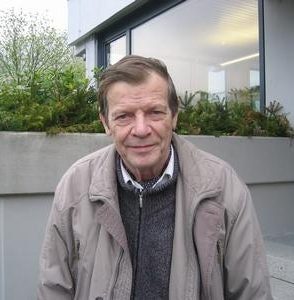The man behind the Monster
Bernd Fischer and the need for precision
The man who first glimpsed the Monster has died. His vision was realised nearly forty years ago in space of 196,884 dimensions.
This was the mathematics of symmetry, which started when the fourth century BC ancient Greek philosopher Theaetatus proved that there are exactly five “Platonic solids”. In each case the faces form a pattern that looks the same from any corner or any face. Perfect symmetry in a mathematical sense, and it led to advances in nineteenth and twentieth-century mathematics. Inspired by this, mathematicians began to search for ever more complex and symmetrical patterns and classify those they had found.
Fischer was willing to stand up for truth and was unafraid to argue against things that were false
This is where the Monster came in. Not a monster at all really but a vast and very beautiful pattern almost impossible to describe. Bernd Fischer, the man who first saw its potential existence, had already discovered some slightly smaller “monsters” that did not fit into any of the known schemes. He constructed three enormous ones, then searched for others by loosening the conditions he had imposed on his earlier work. The result was the Monster and its sidekick the Baby Monster, which he glimpsed at first as through a glass darkly. He later constructed all the data for the Baby Monster, and a small team of experts did the same for the Monster itself. Both were later constructed by mathematicians in America, the Monster by Robert Griess using 196,884 dimensions. Ridiculously high? Yes, but it was the best that could be done.

These were heady days. A team of mathematicians, mainly at universities in America, was hard at work proving that apart from a few exceptional cases we had a complete list of all the basic building blocks for symmetry. At the same time a few mavericks were uncovering evidence of exceptions, without which the list was incomplete. Fischer was one of these. Over cigarettes and the occasional beer, he would engage with anyone who had serious ideas to discuss, and as head of mathematical sciences at the University of Bielefeld in Germany even had to engage with the awkward squad. Student revolutionaries inspired by the events of 1968 in Paris kicked up quite a fuss. They objected to all sorts of things about the way universities were run and in Fischer’s case even demanded that his favourite subject “Group Theory” — the mathematical study of symmetry — be abandoned as part of the curriculum. The reason? Oh, you didn’t need a good reason, but it was abstract and apparently unconnected with everyday life, though even at that time it was finding valuable uses in physics and cryptography.
With Fischer they were up against a serious opponent whose whole career was tied up with pure research, teaching and administration. Exactly what the academic world is all about. He published little, but engaged widely with mathematicians elsewhere, notably in Britain and America. Pursued his own research goals, which turned out to be highly productive and deliver big surprises.
This is what academics are supposed to do. He would have had no truck with the modern fashion of de-platforming people because you disagree with their research, their opinions, or even object to something they once said or tweeted. At a conference many years ago, some participant told me he was a Nazi sympathiser. He wasn’t at all. But he was willing to stand up for truth and was unafraid to argue against things that were false. I used to visit Bielefeld for my research and remember an example he once gave me. During the First World War the French press had carried a story that German troops short on rations received a telegram instructing them to eat the dead bodies. False. The telegram was real, but it used the German word Kadaver, translated into French as cadavre, meaning corpse. The German word for corpse is Leiche. The word Kadaver means carcass. So, the Germans were merely being instructed to eat the carcasses of their dead animals, notably horses.
Care and precision often get swept aside in the interests of propaganda
Did the French journalist deliberately misinterpret the message? Perhaps not, but it goes to show that care and precision often get swept aside in the interests of propaganda favouring a particular cause. Precision is essential. Without it mathematicians can produce false results. Every researcher has found “proofs” of plausible claims that are simply wrong. The fault often lies in some hidden assumption, sometimes occluded by the word “clearly”. The ancient Greek mathematicians were very good at making all assumptions explicit. In his Elements, Euclid defined the terms he was using, stated his theorems carefully, and delineated his proofs in a way that left no gaps and ensured that all steps were precisely explained. Precision is of the essence. Its absence can easily lead to confusion.
When Fischer and others were discovering exceptions to the grand scheme embracing all the known building blocks for symmetry, they needed to be very precise indeed. A great example was the first exception discovered in the twentieth century. John Thompson at the University of Chicago, the doyen of those keen to classify the fundamental building blocks of symmetry had written a paper in the mid-1960s showing that if one of these had a certain type of “cross-section” then it must belong to the known families. He sent his paper around as a preprint to other specialists. One was a relatively unknown man from Yugoslavia, now working in Australia. He read it and wrote Thompson a letter saying he was having a bit of trouble with the smallest case in the new paper. Thompson replied the same day with a brief explanation, but the next morning suddenly realised … whoops there really was a gap in the proof for the smallest case. The man in Australia, Zvonimir Janko knew more than he was letting on, because he had already uncovered evidence for an exception to the grand scheme. He published details a couple of years later, and it set the scene for more, found by Janko, Fischer and others.
As for the Monster, one of the experts who studied it was John Conway at Cambridge, later Princeton. When he visited Chicago, my wife at the time had the temerity to argue with him that it should be possible to understand it without the technical details. At some higher level of understanding it would all become much clearer. He disagreed. Without the technical details it was impossible to understand it. Looking back, I think both were right. The ultimate aim is to see things from a higher level, but what you can’t do is to skip the serious learning. Doing that with students who have never been through the process is to do them a serious disservice, but there are members of the educational establishment today who disagree. Like those revolutionaries from 1968 they are willing to overturn established methods with nothing to put in their place. Once again, we need people like Fischer to tackle their naivety, and allow people of all ethnic groups to progress in the modern world, rather than deflecting them from serious learning.
When I first taught in America as a graduate student, I was asked to teach a course on elementary algebra. One student paid me for private lessons, and I tried very hard to explain what an equation was, and what you do to one side you must do to the other. She had opted out of all mathematics at high school in California, and now more than ten years later couldn’t grasp the concept. It was too late.
Enjoying The Critic online? It's even better in print
Try five issues of Britain’s most civilised magazine for £10
Subscribe














